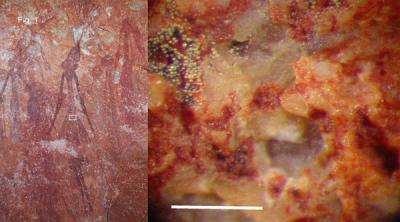January 6, 2011 report
Bacteria and fungi keep some ancient Australian rock art colors vivid

(PhysOrg.com) -- New studies of 80 Bradshaw rock art works in the Kimberley region of Western Australia have shown their colors have not faded because the artworks are coated with a biofilm of bacteria and fungi.
The Bradshaw art works are named after Joseph Bradshaw, a 19th century pastoralist who was the first white settler to discover them. They are known locally as Gwion Gwion. The paintings are estimated to be at least 17,000 years old, and possibly as ancient as 70,000 years old, based on the time of extinction of animals and plants depicted. The paintings are often vivid and have high contrast, even though they are often exposed to the elements, and they are not thought to have been repainted. Other rock art in the same region fades over centuries and is often repainted.
Two of the oldest types of Bradshaw rock art are known as Sash and Tassel, and a research team led by Professor Jack Pettigrew of the University of Queensland studied paintings of these types from 16 sites, using equipment such as portable digital microscopes. They chose the Sash and Tassel styles because there is less controversy about their classification and because they are accepted as the oldest examples of Bradshaw art.
The team found in almost all the paintings the original paint pigments had been replaced by pigmented microbes, which the researchers dubbed “living pigments.”
Professor Pettigrew said the organisms were still living and successive generations would have lived in the paintings for thousands of years, which explains the fresh appearance of the paintings.
One of the many organisms colonizing the works is a black fungus, which is thought to belong to the Chaetothyriales group. These fungi survive by cannibalizing their predecessors in situ. If the original paint contained fungus spores the current organisms could be directly descended from these spores. The researchers found that in 98 percent of cases the fungi remained within the boundaries of the painting, but there were a few examples where the fungi had destroyed most of the art work.
Another organism found is an as-yet unidentified red bacterium, which may be a species of Cyanobacteria. The red microbes were often found with the black fungus. The combination of the two produces colors including red, black, mulberry, and cherry.
Professor Pettigrew and colleagues also speculate the paint used may have contained nutrients that “kick-started” a symbiotic relationship between the black fungi and red bacteria, with the bacteria providing carbohydrates to the fungi via photosynthesis, and the fungi providing water to the bacteria.
The presence of living organisms on the paintings could explain why results of attempts to date the paintings have been inconsistent. Professor Pettigrew said a possible way to date the paintings may be to determine the DNA sequence evolution, and work on this has already begun.
More information: Living pigments in Australian Bradshaw rock art - antiquity.ac.uk/projgall/pettigrew326/
© 2010 PhysOrg.com

















